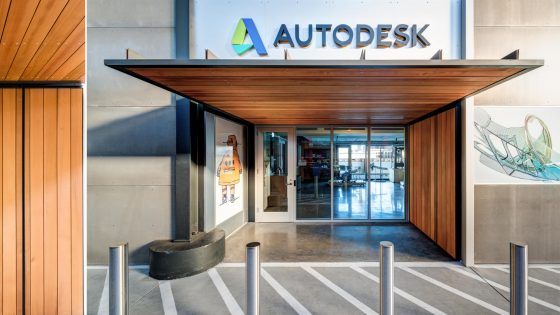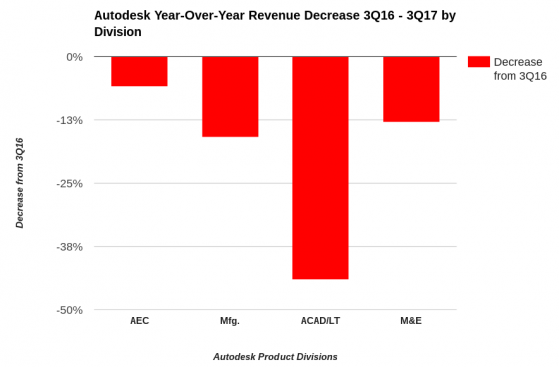The warnings about lower revenue during business model transition are still true. AutoCAD business is in the cellar.
By Randall S. Newton
Autodesk (NASDAQ: ADSK) continues to see revenue declines as it moves through its transition from selling software licenses to selling software subscriptions. Revenue in the third quarter of Fiscal 2017 (ended October 31, 2016) was $490 million, down 18% from the third quarter of fiscal 2016.
Autodesk posted a net loss for the quarter of $142.8 million, compared to a quarterly net loss of $43.8 million a year ago.

Autodesk continues to be upfront about how the transition affects short-term revenue. In a statement announcing results, the company said, “During Autodesk’s business model transition, revenue is negatively impacted as more revenue is recognized ratably rather than up front and as new offerings generally have a lower initial purchase price.” It is our policy to report revenue figures using GAAP standards (Generally Accepted Accounting Principles) but we will also report selected numbers — supplied by Autodesk — regarding how the subscription transition is progressing.
Digging deeper into quarterly revenue and transactions; percentages cited are based on constant currencies, compared to the year-ago quarter:
Regions:
- Americas revenue was $213 million, down 9%;
- EMEA revenue was $191 million, down 15%;
- APAC revenue was $85 million, down 38%.
Product Divisions
- AEC revenue was $212 million, down 6%;
- Manufacturing revenue was $147 million, down 16%;
- AutoCAD/AutoCAD LT revenue was $80 million, down 44%;
- Media/Entertainment revenue was $34 million, down 13%.
Revenue from other sources, including services and consumer products, was approximately $17 million, or 3% of quarterly revenue.

Comparing year-over-year data for the new business model data regarding subscriptions is not yet productive, since the transition is still in progress. New model subscriptions increased 168,000 during the quarter, representing 19% of all model subscriptions. Autodesk defines “model subscriptions” as “product, enterprise flexible license, and cloud subscriptions.” Autodesk says product subscriptions were the most popular option in the quarter. Maintenance subscriptions dropped by 34,000 during the quarter, despite picking up 13,000 subscribers with the acquisition of Solid Angle. Total subscriptions stand at 2.95 million.
Autodesk says recurring revenue in the quarter was 76% of total revenue, compared to being 56% of total revenue a year ago.
What do we think?
Connecting the dots and adding a little observational insight suggests AutoCAD/AutoCAD LT sales tanked. This is a long-term trend as Autodesk pushes 3D modeling in all divisions, but it seems the push to subscriptions is accelerating the pace. The dots:
- Asia/Pacific (APAC) is the strongest market for AutoCAD (regional revenue down 38%)
- AutoCAD/LT revenue down 44% in the quarter;
- Net decrease in maintenance subscriptions, despite an acquisition boost (down 34,000).
Autodesk would like us to believe the sales drop in AutoCAD and LT is because more designers and engineers are moving to 3D. But outside of the Autodesk universe, sales of 2D drafting software are strong. Dassault Systemès now has more users of its 2D software DraftSight than its combined number of professional users of 3D software (excluding education seats). Graebert GmbH and Bricsys, the two leading CAD vendors specializing in 2D, are privately held and do not release revenue statements. However, both report spending on research and development to be up significantly. Both Graebert and Bricsys support the .dwg format popularized by AutoCAD; both are expanding its use into manufacturing and AEC with 3D tools and domain-specific features. With declining AutoCAD sales in one hand, and R&D spending increases on the other hand, it is easy to come to the conclusion that AutoCAD users are headed out the door, but not abandoning 2D CAD.





